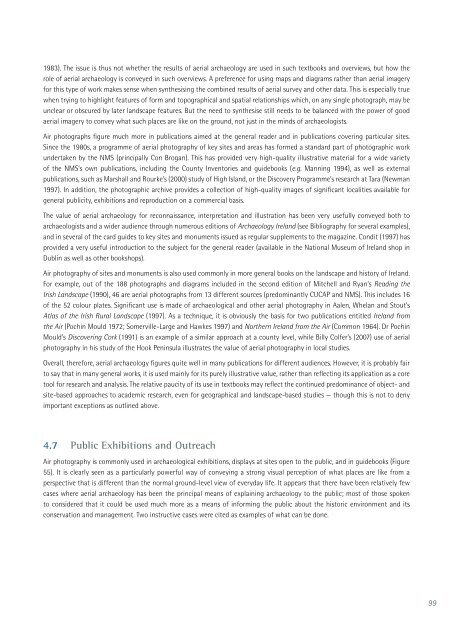Aerial Archaeology in Ireland - The Heritage Council
Aerial Archaeology in Ireland - The Heritage Council
Aerial Archaeology in Ireland - The Heritage Council
You also want an ePaper? Increase the reach of your titles
YUMPU automatically turns print PDFs into web optimized ePapers that Google loves.
1983). <strong>The</strong> issue is thus not whether the results of aerial archaeology are used <strong>in</strong> such textbooks and overviews, but how the<br />
role of aerial archaeology is conveyed <strong>in</strong> such overviews. A preference for us<strong>in</strong>g maps and diagrams rather than aerial imagery<br />
for this type of work makes sense when synthesis<strong>in</strong>g the comb<strong>in</strong>ed results of aerial survey and other data. This is especially true<br />
when try<strong>in</strong>g to highlight features of form and topographical and spatial relationships which, on any s<strong>in</strong>gle photograph, may be<br />
unclear or obscured by later landscape features. But the need to synthesise still needs to be balanced with the power of good<br />
aerial imagery to convey what such places are like on the ground, not just <strong>in</strong> the m<strong>in</strong>ds of archaeologists.<br />
Air photographs figure much more <strong>in</strong> publications aimed at the general reader and <strong>in</strong> publications cover<strong>in</strong>g particular sites.<br />
S<strong>in</strong>ce the 1980s, a programme of aerial photography of key sites and areas has formed a standard part of photographic work<br />
undertaken by the NMS (pr<strong>in</strong>cipally Con Brogan). This has provided very high-quality illustrative material for a wide variety<br />
of the NMS’s own publications, <strong>in</strong>clud<strong>in</strong>g the County Inventories and guidebooks (e.g. Mann<strong>in</strong>g 1994), as well as external<br />
publications, such as Marshall and Rourke’s (2000) study of High Island, or the Discovery Programme’s research at Tara (Newman<br />
1997). In addition, the photographic archive provides a collection of high-quality images of significant localities available for<br />
general publicity, exhibitions and reproduction on a commercial basis.<br />
<strong>The</strong> value of aerial archaeology for reconnaissance, <strong>in</strong>terpretation and illustration has been very usefully conveyed both to<br />
archaeologists and a wider audience through numerous editions of <strong>Archaeology</strong> <strong>Ireland</strong> (see Bibliography for several examples),<br />
and <strong>in</strong> several of the card guides to key sites and monuments issued as regular supplements to the magaz<strong>in</strong>e. Condit (1997) has<br />
provided a very useful <strong>in</strong>troduction to the subject for the general reader (available <strong>in</strong> the National Museum of <strong>Ireland</strong> shop <strong>in</strong><br />
Dubl<strong>in</strong> as well as other bookshops).<br />
Air photography of sites and monuments is also used commonly <strong>in</strong> more general books on the landscape and history of <strong>Ireland</strong>.<br />
For example, out of the 188 photographs and diagrams <strong>in</strong>cluded <strong>in</strong> the second edition of Mitchell and Ryan’s Read<strong>in</strong>g the<br />
Irish Landscape (1990), 46 are aerial photographs from 13 different sources (predom<strong>in</strong>antly CUCAP and NMS). This <strong>in</strong>cludes 16<br />
of the 52 colour plates. Significant use is made of archaeological and other aerial photography <strong>in</strong> Aalen, Whelan and Stout’s<br />
Atlas of the Irish Rural Landscape (1997). As a technique, it is obviously the basis for two publications entitled <strong>Ireland</strong> from<br />
the Air (Poch<strong>in</strong> Mould 1972; Somerville-Large and Hawkes 1997) and Northern <strong>Ireland</strong> from the Air (Common 1964). Dr Poch<strong>in</strong><br />
Mould’s Discover<strong>in</strong>g Cork (1991) is an example of a similar approach at a county level, while Billy Colfer’s (2007) use of aerial<br />
photography <strong>in</strong> his study of the Hook Pen<strong>in</strong>sula illustrates the value of aerial photography <strong>in</strong> local studies.<br />
Overall, therefore, aerial archaeology figures quite well <strong>in</strong> many publications for different audiences. However, it is probably fair<br />
to say that <strong>in</strong> many general works, it is used ma<strong>in</strong>ly for its purely illustrative value, rather than reflect<strong>in</strong>g its application as a core<br />
tool for research and analysis. <strong>The</strong> relative paucity of its use <strong>in</strong> textbooks may reflect the cont<strong>in</strong>ued predom<strong>in</strong>ance of object- and<br />
site-based approaches to academic research, even for geographical and landscape-based studies — though this is not to deny<br />
important exceptions as outl<strong>in</strong>ed above.<br />
4.7 Public Exhibitions and Outreach<br />
Air photography is commonly used <strong>in</strong> archaeological exhibitions, displays at sites open to the public, and <strong>in</strong> guidebooks (Figure<br />
55). It is clearly seen as a particularly powerful way of convey<strong>in</strong>g a strong visual perception of what places are like from a<br />
perspective that is different than the normal ground-level view of everyday life. It appears that there have been relatively few<br />
cases where aerial archaeology has been the pr<strong>in</strong>cipal means of expla<strong>in</strong><strong>in</strong>g archaeology to the public; most of those spoken<br />
to considered that it could be used much more as a means of <strong>in</strong>form<strong>in</strong>g the public about the historic environment and its<br />
conservation and management. Two <strong>in</strong>structive cases were cited as examples of what can be done.<br />
99

















